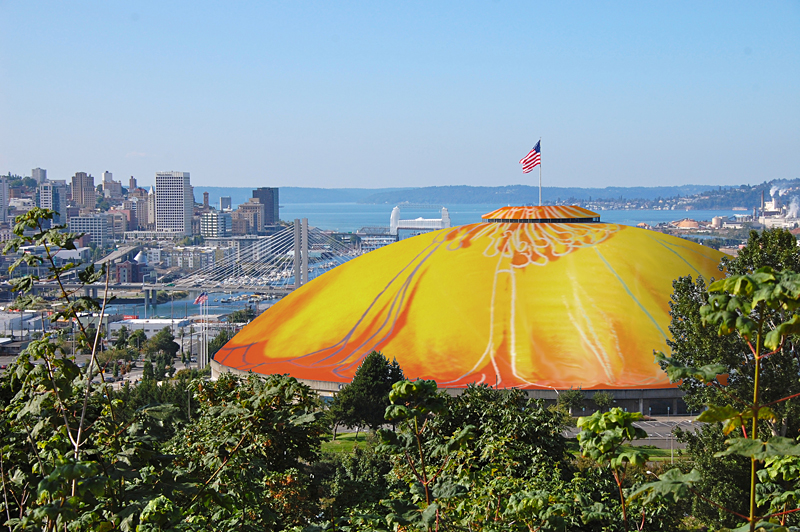Imagine that when the Kingdome went up in 1976, one of the world’s most famous living artists had offered a giant image to adorn the roof. Wouldn’t any city be delighted to receive a major art installation by Andy Warhol? Yet the reception was very different in 1982 when the Tacoma Dome opened. To decorate the new structure, thanks to Tacoma’s 1-percent-for-art program (then a fairly new notion), $280,000 was allocated from the T-Dome budget. But what kind of art would it buy? A panel was established, including local citizen advisors and three national experts (architect Michael Graves among them), and solicited proposals. Claes Oldenburg and Roy Lichtenstein turned down the paltry $4,500 honorarium. Five artists agreed to submit designs, with Andy Warhol the boldface name of the group. The advisory panel would consider public opinion before making its recommendation, then subject to a city council vote. And that is where the museum show Andy Warhol’s Flowers for Tacoma gets interesting.
After the shock and success of his Brillo boxes and Campbell’s Soup cans, Warhol was casting about for a new idea in 1964. He wanted to reproduce something that was not already a commodity, something that would be—in an ironic way—pretty and traditional. A friend pointed to a photography magazine that lay open to a shot of four hibiscus flowers. Perfect! Warhol cut it out, created a silk screen, and eventually sold hundreds of large reproductions in his Flowers series.
Many iterations of Flowers are on view at TAM, and so are the background materials. We see the original Modern Photography source image (never credited, of course), a silk screen and other studio aids, and numerous photos of the production work in Warhol’s famous Factory, several of whose denizens appear in separate portraits. (In a witty touch, TAM has wrapped some of its portable walls in tinfoil, just like the Factory.) The exhibit is actually a survey, from Warhol’s commercial art in the ’50s to his final few flower sketches in the ’80s, when he took to copying images from Japanese ikebana floral-arrangement books. Warhol returned to flowers several times during his long career, helpfully detailed in a timeline by TAM curator Rock Hushka, and it was a giant orange daisy that he proposed to drape over the top of the T-Dome.
Background materials also reveal the commercial and mechanical details behind Warhol’s proposal, and his art in general. Under glass are copies of correspondence from the Factory to Tacoma bureaucrats and panelists. It would’ve been helpful to see renderings of the other four proposals (one by James Rosenquist, no slouch), but the show does usefully provide news clippings that document local resistance to public-funded art. “Warhol: Idealism or Satire?” read one Tacoma News Tribune headline. A letter to the editor called the proposed expenditure “sheer idiocy,” and continued, “One cannot eat paintings.”
Questions persisted when the five proposals went on view at the University of Puget Sound for public comment. Why was a local artist not considered? Where were the Native American motifs, the salmon, the mountains and trees? Why spend tax dollars on something so frivolous? Some called the Tacoma Arts Commission to complain about Warhol. Who was this fey New York elitist, this Studio 54 celebrity, to dictate the tastes of a proud lumber town? In our own pages, Fred Brack wrote of the controversy, “All of this should make us Seattleites envious. If Tacoma won’t accept Warhol, we should.”
Tacoma’s 1-percent-for-art program was, at the time, only 7 years old and uncontroversial. But, as TAM placards explain, the pricey pitches so angered the public that the city council repealed the measure in 1985. When tempers cooled, with Warhol (1928–1987) dead and forgotten, the council reinstated it in 2000. But what a lost opportunity. As designed, Warhol’s big daisy would’ve served a double purpose, as artwork and an advertisement for himself. It was he who would be lending his fame to the dome; he’d be doing Tacoma a favor, and he knew it. The arena sits on an ugly stretch of I-5 already cluttered with signage, so why not another billboard? It’s a place of sports, trade shows, monster trucks, and music produced on an industrial scale, where Lady Gaga will perform in January. It’s a shrine not to art but commerce. An inorganic, supersized daisy would’ve been a fitting garland for the venue, surely to become known as the Warhol Dome.
And here’s a final irony: The panel and city council rejected Warhol in favor of Stephen Antonakos, a New Yorker whose neon waves—originally to be affixed to the roof—were then installed inside the dome, out of public view (unless you’re a Justin Bieber fan). Today, as TAM commemorates the 30th anniversary of Warhol’s proposal, there’s talk of finally installing his flower over the provisional blue triangles that still decorate the dome’s roof. The cost would be greater, but remember that the T-Dome’s original budget ballooned from $28 to $44 million. Adjust for inflation, and you’d now have $1 million—not $280,000—to spend on Warhol’s art. Or Tacoma taxpayers could just visit their museum instead.








